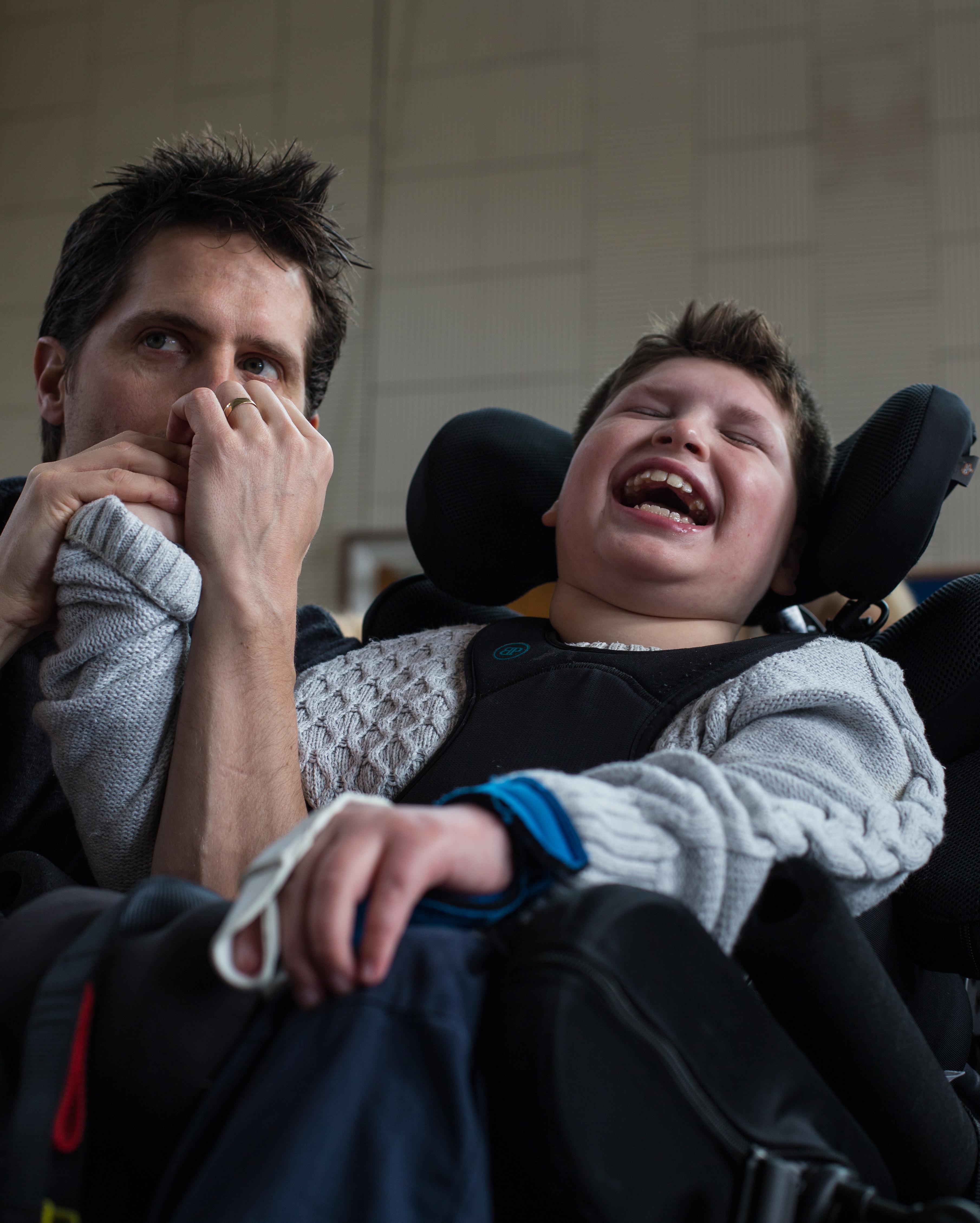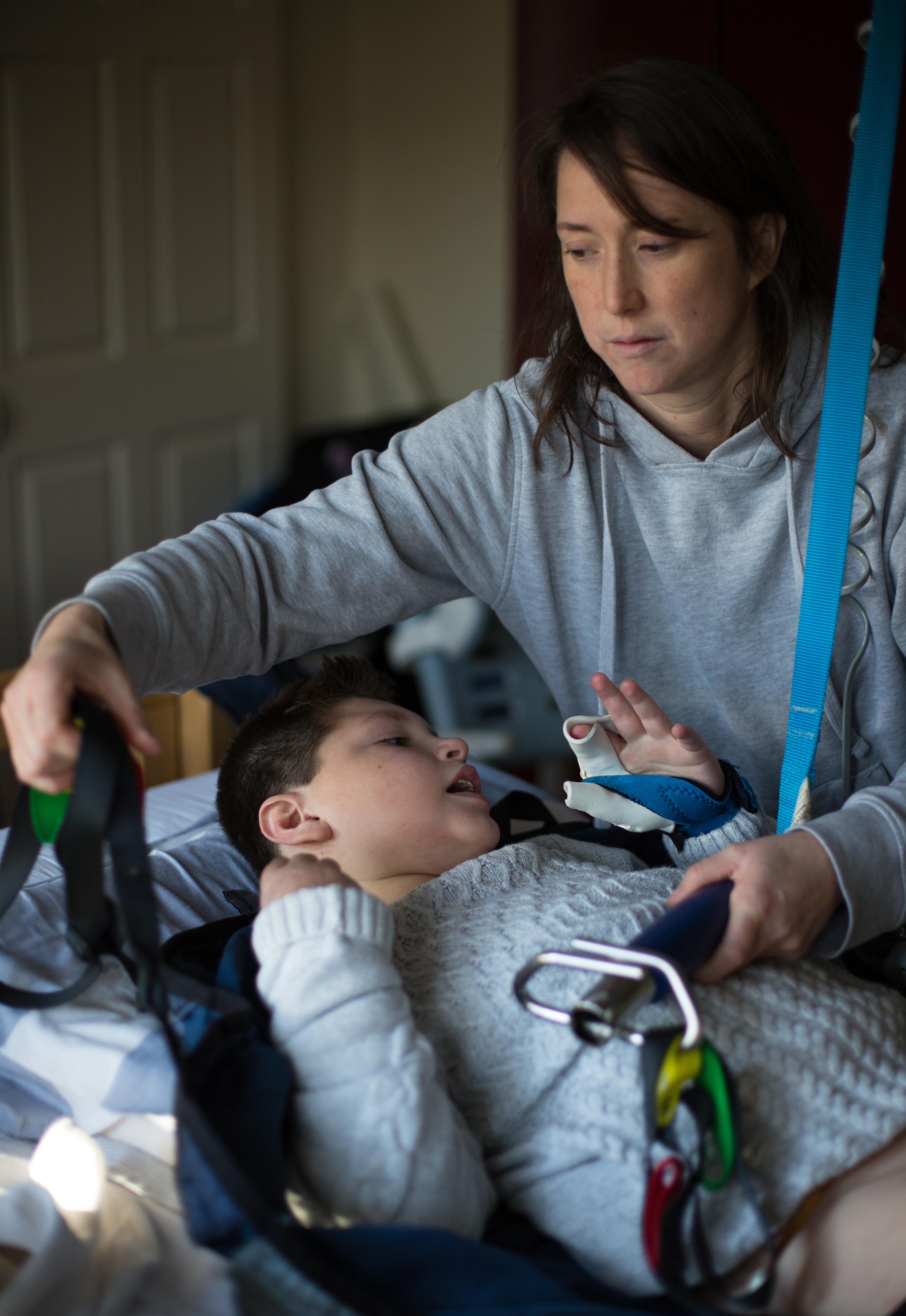
13 minute read
Sam and Rachel’s story
Rachel Wright is a qualified nurse and an unqualified mum of 3, parenting a son with complex disabilities and life-limiting epilepsy. Author of two books including The Skies I’m Under, award winning blogger, speaker, CPD accredited trainer and founder of Born at the Right Time, she’s passionate about effective communication, co-production, community and embracing life’s challenges. An expert through lived experience, Rachel works towards bridging the gap between families of children with complex conditions and the practitioners who support them.
No one is prepared for the chaos of parenthood.
Advertisement
The change from ‘Keys, wallet, phone,’ to, ‘Bag, wipes, nappies, cream, change of clothes, muslin, nappy sacs and on and on and on.’ Just leaving the house is difficult. But when our first son was born, it was even more complicated than we anticipated. Sam was born by emergency C-section, having not felt him kick for a few hours. When he did arrive, he failed to breathe and was immediately ventilated. Instead of cooing over a new-born and try to breastfeed, my husband and I peered into a clear, plastic incubator with tubes, wires and our son. From the beginning, our life as parents was not what we had expected it to be.
At 10 weeks old, an MRI scan of Sam’s brain confirmed our greatest fears. He had severe and complex brain damage. This would result in life-changing disabilities although we didn’t know what the future would hold.
Our hopes were replaced with fears and anxieties.
Initially, our little boy smiled and babbled like his peers but after only a few months he was noticeably different. Where my friends’ babies grasped toys and rolled, my son’s minimal movements continued on repeat, rarely changing. He was like my teenage Game Boy with black and white Tetris, while my friend’s children were flying high with the latest version of Forza Motor sport on the Xbox. The comparison felt mind-boggling at times.
As I held my nephews, I noticed they sat differently on my hip. I looked on enviously as they whimpered when their mothers left the room. Then their soft, hopeful arms reach into the air on their mums’ return. Each difference stung with a painful reminder of what we were missing. In our terraced house, left alone I doted on my son and cherished every smile and giggle. I loved him in a way I hadn’t before experienced. Yet, when in the public eye, I hid my grief as best I could for all the ‘what ifs’ and losses I felt.
I had stepped beyond my world of understanding into an unpredictable alternate universe. As a nurse I felt capable and empowered. As a parent I was unqualified and daunted. Initially we lived in the of the eye of the storm, where everything happened automatically. Then our lives were invaded. From every angle people were telling me what to do. Whether it be the specially trained professionals or my friend’s hairdresser who read an article in the Daily Mail. Everyone had advice about how this would all get better or simply go away. The resulting emotion was one of vulnerability. I could no longer live under the myth that I was in control of my life. It seemed every action, every decision, piece of equipment or therapy, was determined and controlled by someone else. I was exposed and ill-equipped for the life I was living.
By nine months of age, sitting remained a dream for Sam and all the beautifully decorated baby equipment didn’t meet his needs. High chair, push chair, play mats and bath seats, all needed to be tweaked or adapted to provide enough support. Soon I had made friends with the workers in a local furniture repair shop who would cut and cover bits of foam for me. The wheelchair service at the time included an angel in the form of a woman who sewed and crafted wedges and supports in just the right shape.
The changes were breath-taking.
The professionals who took their time to explain not just what needed to be done but why, empowered me to use that knowledge in all of Sam’s life. Before long we were looking at Sam’s first piece of disability equipment and it made me wince. Straps and supports, footplates and headrests, it looked more like torture equipment than the bright and cheerful items I saw in magazines. I found myself in the strange position of having to argue and fight for pieces of equipment I knew Sam needed and would benefit from. Then when they finally arrived, I realised I didn’t want them at all. They were ugly and cumbersome and reminded me of how different life was – at a time when I simply didn’t feel ready. But maybe we are never ready until we are forced to be.
Then the day came when the idea of support during the night was shared with me. Despite being a nurse, I had never seen a sleep system in place. After another routine physiotherapy session, I slumped into a chair and wept with a friend about how nothing in our lives was sacred.

Sam’s sleep system
Everything had been affected by the impact of disability.
I couldn’t feed my son the same way.
I was instructed to play with him differently.
I was encouraged to alter the way I spoke to him.
We struggled to find a mobile high-chair which gave enough support (the Goto and Scollop hadn’t been invented).
His high chair at home was wooden with straps and headrest instead of cartoon jungle creatures and bright colours.
A normal buggy left Sam slumped to one side.
The baby bath seat was too small and the toddler one didn’t have enough support.
All the age appropriate toys weren’t appropriate at all.
I felt overwhelmed at life feeling so different.
Now I couldn’t even put my son to bed without someone else telling me how to do it. At the same time as trying sleeping positioning, Sam started having seizures. His nights were disturbed and whatever equipment we tried were required to be taken away two hours later. I needed to resettle him without equipment before he would finally drift off. Then once asleep, I would put the equipment back in place trying not to wake him. The disruption to my own sleep made life even more challenging. After worsening epilepsy and various attempts, we settled on Sam sleeping on his side with support to minimise the impact on his spine and hips. It felt like a compromise but one which worked for us.
From the outside, the hard work we had put into place to support Sam 24-hours a day had worked. From the inside what had once felt strange became our new normal. We lived life well and made all sorts of wonderful memories. We ensured we had equipment that meant we could explore and camp in the outdoors. Being in nature was a big part of our life and with hard work and creativity this continued. We dragged Sam in his Hippocampe up mountains, across rivers, in the sea and along country lanes. As a family we went on adventures to our local beach and the heights of Norway. We were like every other family making memories and having fun. Yet we weren’t like every other family. Activities taken for granted by many only happened with thousands of pounds of equipment, a lot of energy and the military precision of launching a rocket into space.
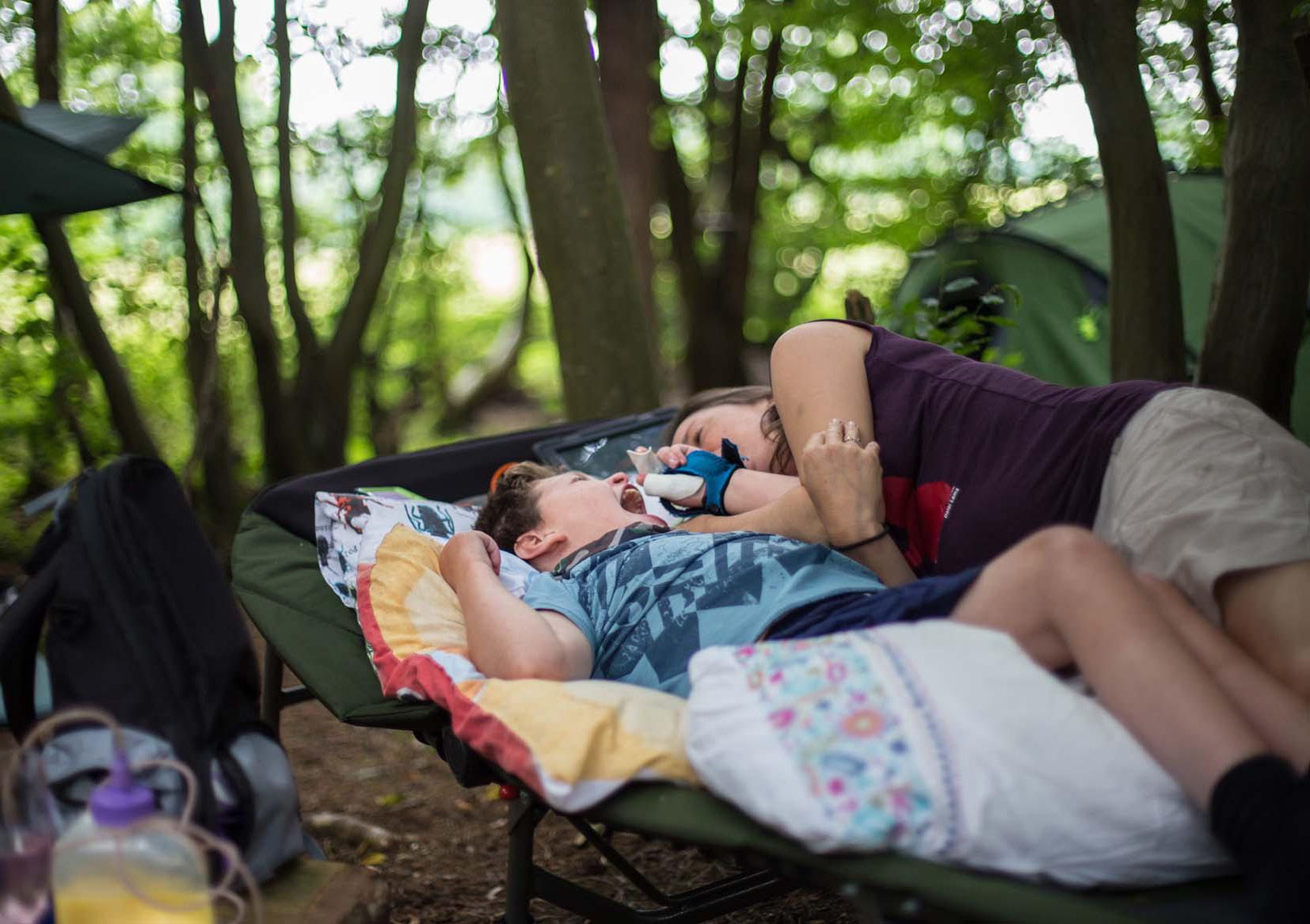
Sam is so much more than what he cannot do.
As Sam has grown, he has exerted his personality. His love for music is firmly established along with swimming being his favourite pastime. He knows his favourite films and is obsessed with the game show Pointless (I think I hear Alexander Armstrong’s voice more than my husband’s). He makes sure his brothers know when he isn’t happy with their choice of programming - screaming, shouting and crying, all of which will instantly stop as soon as he has his own way. With a growing team of carers, came Sam’s preference for the attention of young women. When young carers come to play or take Sam out, he makes it very clear his mum is not welcome. Sam prefers safe and known, gravitating towards what he has already done. Every day we continue to try and expand his world and give him a variety of experiences.
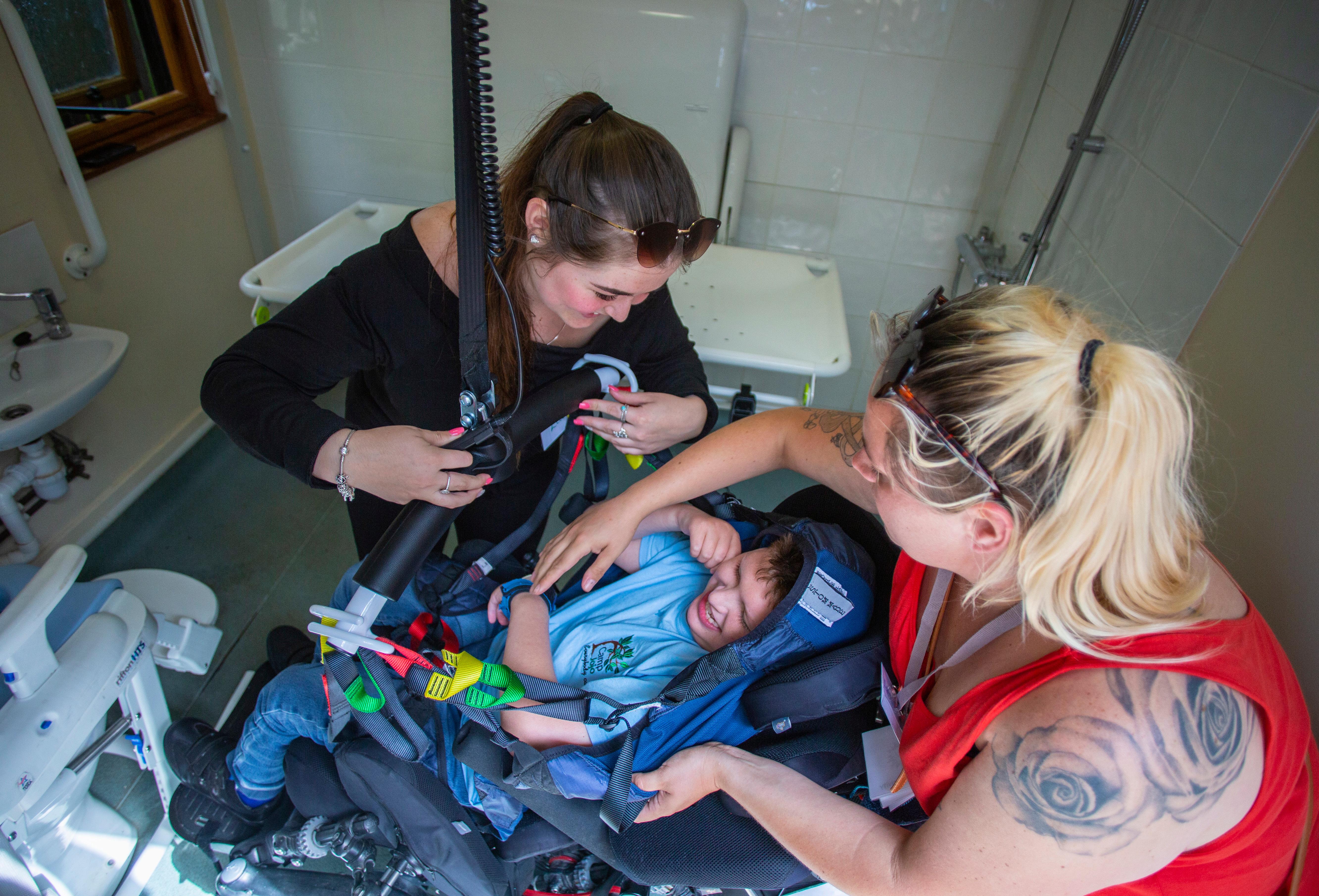
Some days it even feels like we are winning.
Sam can sit relatively straight (when supported) in his chair or bed. He can lift his head and open his hands. He can lie on his front and enjoys time in his walker. Painful spasms are rare and Sam enjoys a good quality of life with a variety of experiences in his day.
At least, that was true until aged 12, when parts of Sam’s life started being limited because of pain. Once previously enjoyed activities were no longer possible. When we decided these changes affected his quality of life, Sam was booked in for surgery to reconstruct both of his hips.
The flood of guilt took my breath away.
Now the ‘What if’s’ sat firmly at my own feet.
What if I had tried harder?
What if I had been more creative in using the equipment?
What if I had persisted?
Could I have managed to avoid the deterioration in his body and resulting major operation?
So many unanswerable questions.
Working with the incredible team at Simple Stuff Works changed everything. I began to more fully understand the mechanisms of body shape changes which occur in children (and later adults) with movement limitations. A person with no physical restrictions moves throughout the whole day. Whether it is rolling around in bed when asleep, walking, running, raising an arm to open a cupboard door or catch a ball. Movement happens 24-hours a day and our body is protected through it. But the smallest of limitations can change our movements in a way that can put extra stress on our body.
Everyone knows how a sprained ankle can give backache because of the way we start walking differently to avoid pain. Multiply these small, persistent movement changes to all day and all night, every day and every night for decades. What seems insignificant can, over time, have a major influence on long-term health.
When Sam was small, his body naturally wanted to curl up into a foetal position to sleep. Without the usual rolling and changing position the result of staying in one position for a long period of time was badly affecting his body. It wasn’t dramatic or alarming. Rather like the silent killer of carbon monoxide poisoning, the slow, persistent effect of a poor position was quietly having a life-changing impact.
Simple Stuff Works worked with me.
In sharing my real life, my fears, goals, restrictions and routine, Simple Stuff Works helped me to replace my guilt with change. Small positive steps which meant we were heading in the right direction. It became clear the work with postural care is relentless. Sam and his body are constantly fighting gravity, the tightening of muscles and altered growth of bones, just to stay straight and pain free.
Our postural care for Sam didn’t change overnight. With knowledge and the support of a team ready to listen and work with us, hurdles were faced together. Small sustainable changes have been made. Over a year after surgery, Sam is no longer on daily painkillers. He continues
to move his legs more and now sleeps on his back. But as he heads into puberty, we know that keeping his spine straight will be a long fought battle that will carry on whilst I’m doing laundry, cooking dinner, working, trying to live my own best life and even when we are all sleeping.
I wish I’d realised Sam had one precious body which needed protecting.
I only carry eggs in an egg box and always put my young children in a car seat. In the same way, one of my vital roles as a parent is protecting Sam’s one body. He uses that body to turn his head and watch the TV, to feel his environment, to splash the water and relax at night. I think I saw the equipment and changes in position as restrictions and work. Now I can see they give him his freedom and best kind of future. What once felt like the constraints of disability, I now see at the gateway to opportunity.
Caring for Sam’s body through 24-hour postural care is simple, but not easy.
The principles we look to are simple;
1. Support Sam throughout the day in a way which keeps his body naturally straight from head to toe. Allowing movement of arms and legs where possible. With arms forward, avoiding slumping to one side and avoiding head dropping forward.
2. Ensure Sam changes position every couple of hours – sitting, lying (front and back), free movement swimming, cycling, standing sling, walker. Using whatever equipment he enjoys and can relax in.
3. Encourage daily active movements. It is easy to always to ‘do to’ Sam but it is vital to let his body learn what happens when it tries to move itself.
4. Sam to lie on his back at night. This keeps his body in the best natural position.
He has support under his knees, along his chest and under his heels. This means when Sam is relaxed and asleep his body is able to grow without distortion helping him to have maximum fun during the day.
It’s a team effort.
From the carers who help us at home, to the staff at school, everyone knows what Sam’s needs are and the principles of care we are working to. We know this is a marathon, not a sprint. Everyone is trained and supported as needed. Some days we work hard and get it right. Some days are filled with other priorities like a family day out, camping under the stars or simply relaxing.
Parents like me.
I frequently feel as though I have a shopping trolley full of advice which I simply don’t have the emotional or physical energy to ‘pay’ for. So I try to remind myself every day that I only have two hands, 24-hours a day and one precious life. As much as I love my children, I want them to see me living well too. I want them to grow up knowing they deserve a life of love, laughter and hope – just like their parents. So I will continue to try and do what I can, and leave my guilt with the great undone at the end of the day. I will prioritise fun and rest as much as work and therapy. I will work with professionals, using their skills and expertise, being clear with boundaries and expectations. I will choose my mental health in conjunction with my child’s physical health because I know I need to be on the top of my game for my family to not just survive but thrive.
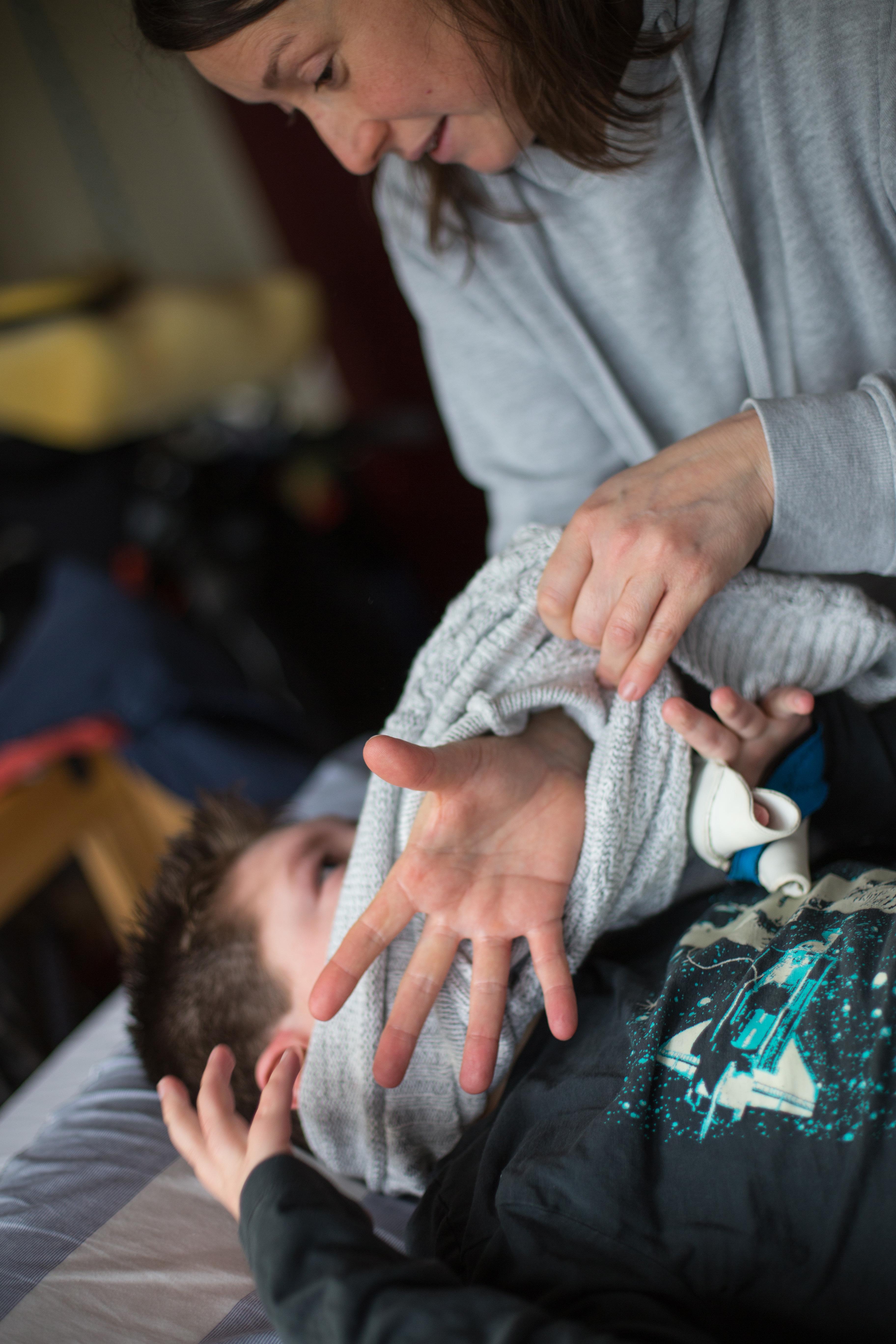
#Bridgingthegap
In 2015 I shared our story of becoming the parents of a child with complex needs in The Skies I’m Under. Since then I have slowly built a business focused on bridging the gap between families of children with complex needs and the professionals who support them. Through public speaking and CPD accredited training, I empower professionals with the reality of lived experience, research and best practice. We aim to promote effective communication and co-productive working with relatives and carers. I know first-hand that the greatest support, advise and consultations happen when my vulnerability as a parent sparks listening, creativity and collaborative working on the part of the professional.
Postural care, like so much, can feel like a mountain to climb. This particular peak however, is best faced alongside experts who listen, encourage and equip us for the journey and inevitable hurdles ahead. It helps to know that this complex and sometimes painful life is also blessed with the most profoundly beautiful and breath-taking views only found at the top of a mountain.
